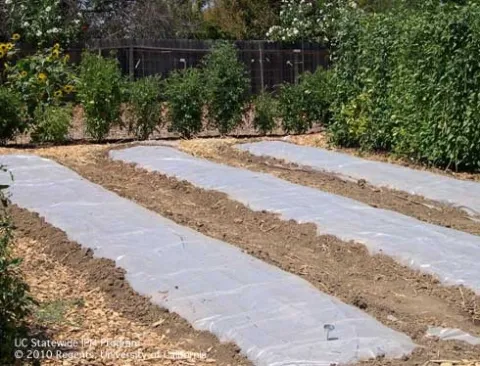Soil solarization is a simple technique that you can use in your home garden to reduce or eliminate many soil-inhabiting pests. Solarization works by heating up the soil in the presence of moisture to temperatures that are high enough to kill many fungi, nematodes, weeds and weed seeds.
In order to solarize your soil, you must leave a clear plastic tarp on the soil surface for 4 to 6 weeks during the hottest part of the year, which of course is now. Black or colored tarps will not allow the soil to get hot enough, so you must use transparent plastic. Polyethylene plastic 1 mil thick is the most efficient and economical, but you must handle it carefully because it rips and punctures easily.
Before laying the plastic down, clean up all weeds, debris and large clods, then level and prepare the soil as for planting. The closer the tarp to the soil, the hotter the soil becomes. Air pockets caused by clods or debris will decrease the effectiveness of the treatment. A smooth, bare soil surface is best.

You must also wet the soil before covering it with the tarp. The moisture causes organisms to be more sensitive to heat and also allows the heat to penetrate deeper into the soil. It's best to wet the soil thoroughly before laying the tarp.
While some pests may be killed within a few days, 4 to 6 weeks of treatment in full sun during the summer is needed to kill most pests with solarization. The highest soil temperatures will occur when the days are long and hot, and when the sky is clear and there is no wind.
Many disease organisms are effectively controlled with solarization, including the fungi that cause Verticillium wilt, Fusarium wilt and damping off of seedlings. Many annual weeds are also controlled, but perennial weeds such as Bermudagrass, field bindweed, johnsongrass, and yellow nutsedge are suppressed but not completely controlled by the procedure. Nematode populations are also reduced, but the heat may not penetrate deep enough to destroy those below the top foot of soil. Nematodes should be controlled well enough for shallow-rooted crops.
Once the solarization is completed and you've removed the tarp, take care not to disturb the soil very much. Turning the soil can bring up living weed seeds and diseases that were too deep to be destroyed by the heat.
Read the publication Soil Solarization for Gardens & Landscapes for more information.

